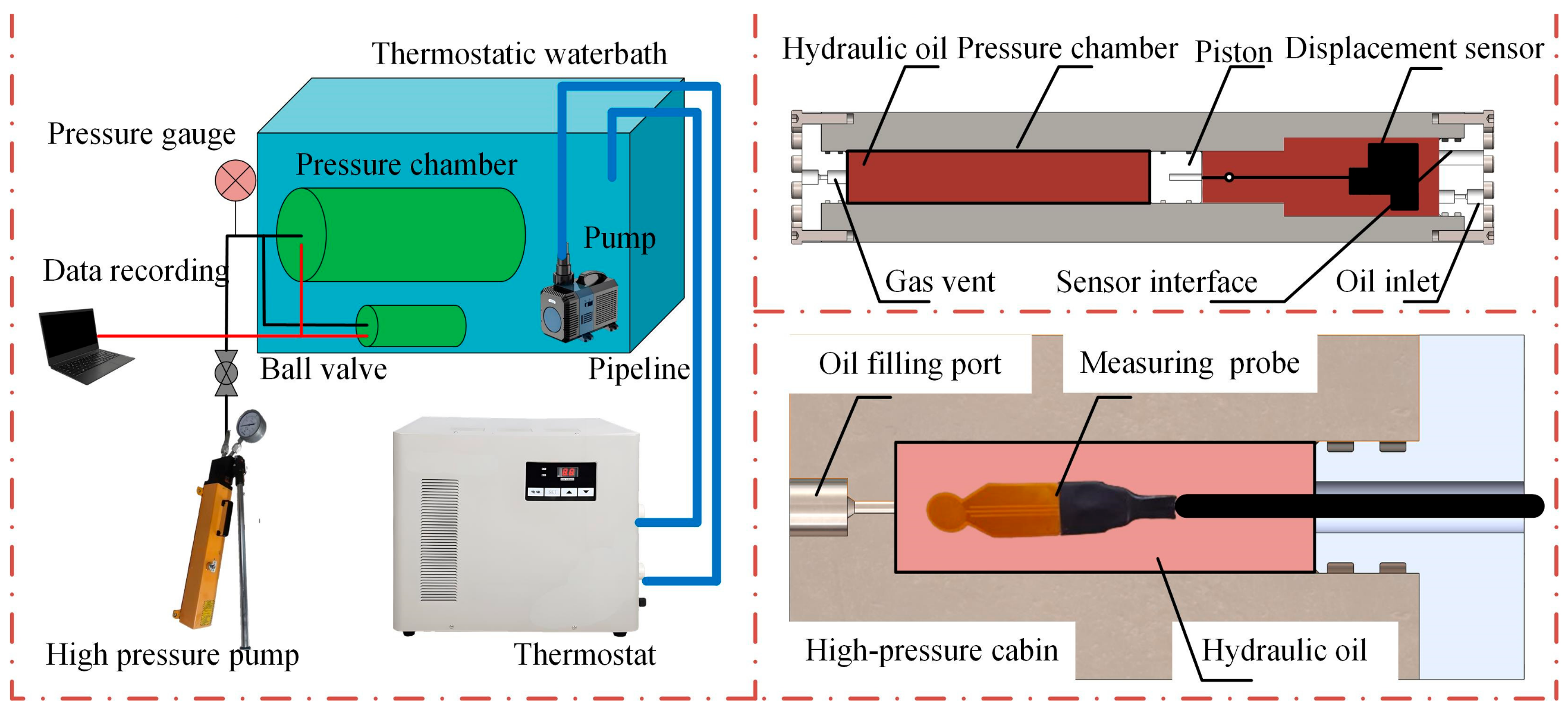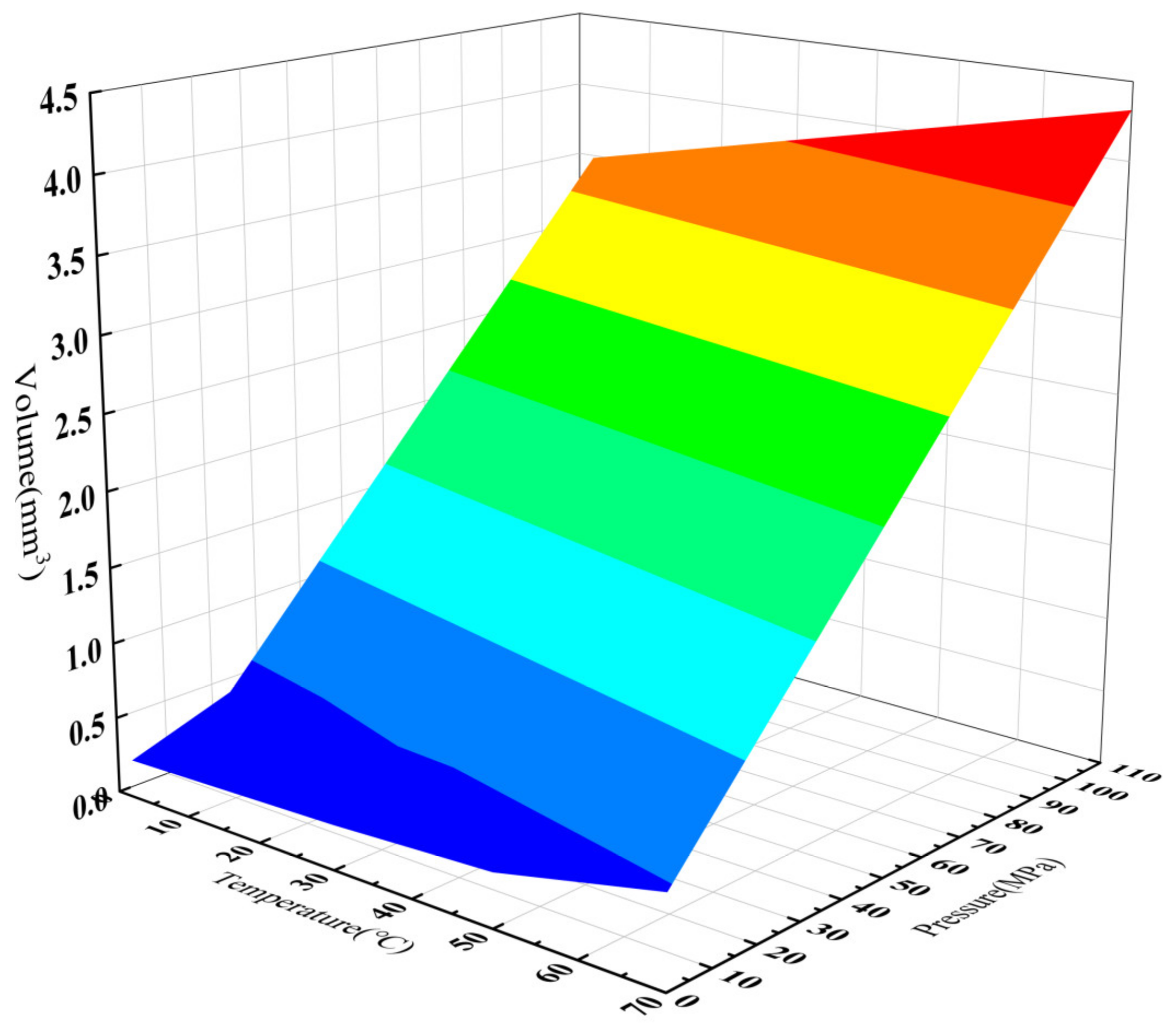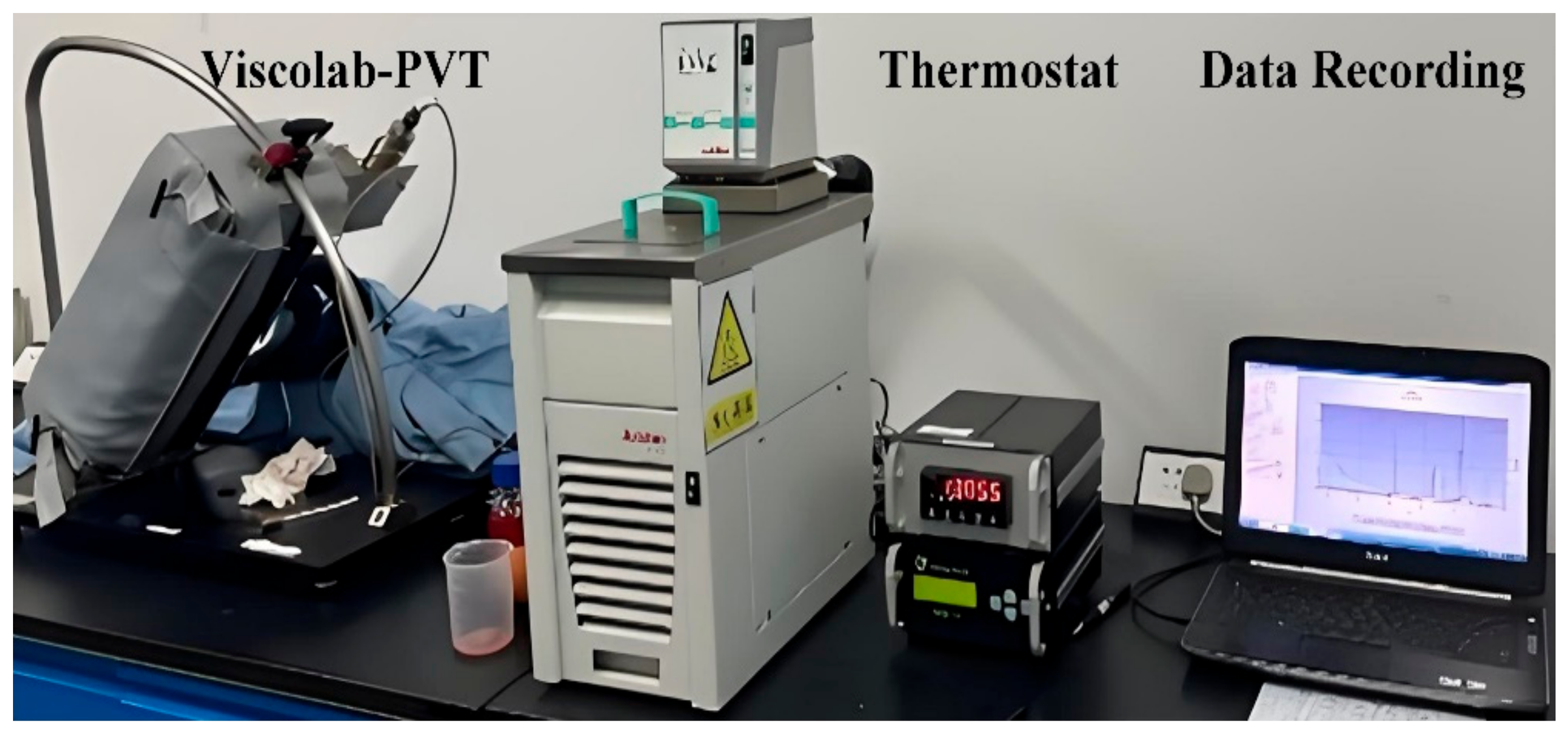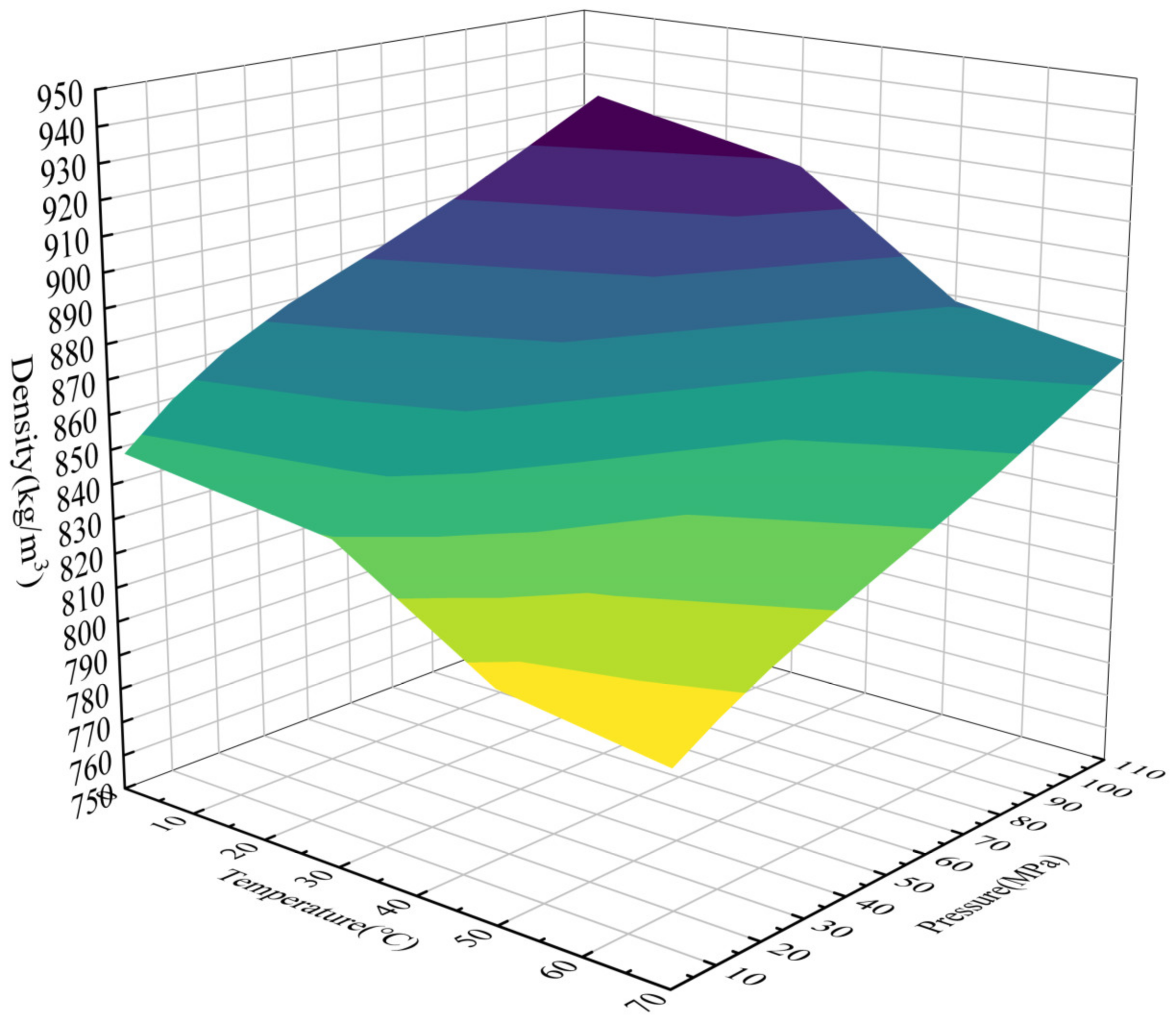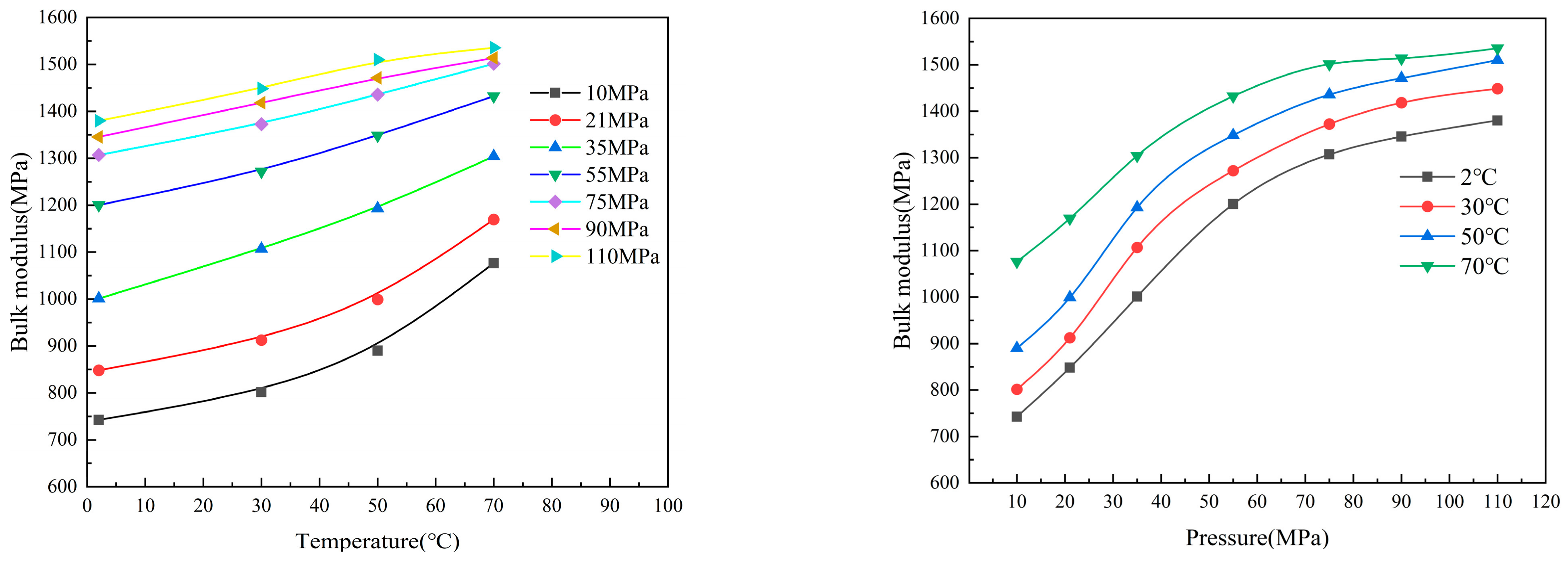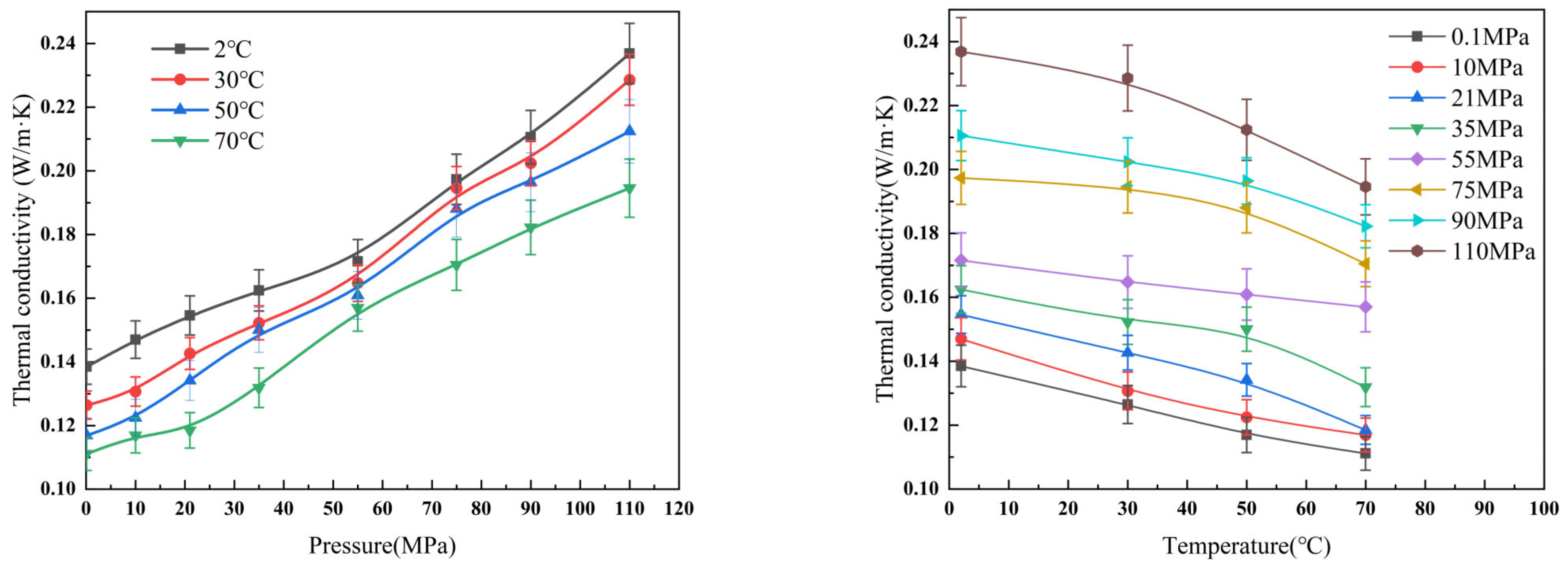1. Introduction
The deep sea harbors abundant marine mineral and biological resources, representing a valuable asset for human sustainable development. The exploitation of these marine resources necessitates reliable equipment and technology for support [
1,
2]. Benefiting from its small size, lightweight design, and stepless speed regulation, the deep-sea hydraulic power source is widely utilized in propulsion systems for subsea equipment [
3,
4,
5,
6,
7]. Its transmission system demonstrates characteristics such as high structural stiffness, compact design, strong load-bearing capacity, superior power-to-weight ratio, and rapid response, making it a crucial power source for deep-sea applications including scientific sampling [
8,
9,
10], mineral resource exploitation [
11,
12,
13], and underwater robotics [
14,
15,
16].
The bulk modulus of hydraulic oil, a crucial parameter influencing the natural frequency, stiffness, as well as static and dynamic characteristics and control accuracy of hydraulic systems is significantly affected by deep-sea conditions [
17,
18,
19,
20,
21,
22]. Moreover, the bulk modulus of liquids exhibits notable temperature dependence [
23,
24] and pressure dependence [
25,
26]. The gas content has a substantial impact on the bulk modulus of oil at low pressures [
27,
28,
29]. In deep-sea operating environments, changes in temperature and pressure alter the bulk modulus of oil, subsequently influencing the dynamic response of hydraulic systems [
30,
31].
The bulk modulus of liquids is primarily classified into isothermal and isentropic types [
32,
33]. During stable operation and descent from sea level to operating depth, the underwater hydraulic system maintains thermal equilibrium with the ambient environment [
34,
35,
36], equivalent to isothermal compression [
37,
38]. During operation, particularly in plunger pumps, hydraulic oil compression occurs over extremely short durations, rendering its working process akin to isentropic compression [
39]. However, experimentally simulating an adiabatic and isentropic environment where compression is instantaneously completed is challenging; thus, isothermal compression is often used as a substitute, with negligible errors for engineering applications. Various methods exist to measure bulk modulus variations with temperature and pressure, including the compression method [
40,
41,
42,
43], sonic velocity method [
21,
44,
45,
46], mass variation method [
47,
48], and ultrasonic grating method [
49,
50,
51,
52,
53]. Currently, however, no device employing these methods measures the bulk modulus under full-ocean-depth and wide-temperature-range conditions, nor is there a theoretical model accurately describing oil bulk modulus variations [
47].
In marine environments, the thermal conductivity of hydraulic oil is influenced by the coupled effects of temperature and pressure. Current measurement techniques for liquid thermal conductivity are primarily categorized into steady-state and transient methods. Steady-state methods include guarded hot plate, heat flux sensors, and hot box techniques, whereas transient methods encompass hot-wire, probe, hot disk, transient plane source, and laser flash approaches [
54,
55]. Researchers have employed various techniques, such as spectral analysis by Hendrix et al. for transparent liquids [
56], point heating by Watanabe et al. for molten salts [
57], and consistency comparisons among hot-wire transient, photon spectroscopy, and laser flash methods by Kwon et al. [
58]. Kobatake, H. et al. quantified the thermal conductivity of molten silicon via non-contact modulated laser calorimetry [
59]. The 3-Omega method has proven effective for measuring cryogenic liquid thermal conductivity [
60,
61]. Chen et al. developed an improved thermal pulse technique suitable for microscale liquid characterization, particularly nanofluids, albeit limited by dielectric film thermal conductivity and thickness [
62]. Mendiola-Curto et al. employed thermoelectric module impedance spectroscopy for liquid thermal conductivity evaluation [
63]. Bioucas investigated the temperature-dependent thermal conductivity of glycerol at 0.1 MPa [
64]. The transient hot-wire method has been extensively validated for both gaseous and liquid media [
65,
66]. Kutcherov observed a pressure-dependent linear relationship in crude oil thermal conductivity at 1 GPa, monotonically increasing with pressure [
67]. Alharbi et al. demonstrated a positive correlation between thermal conductivity and temperature for water at atmospheric pressure (0.1 MPa) within the range of 0–32 °C [
68]. However, systematic studies on the pressure and temperature dependence of hydraulic oil thermal conductivity under deep-sea conditions are scarce. Systematic characterization of these dependencies is crucial for optimizing the design of future deep-sea hydraulic systems.
The functionality of the hydraulic system, encompassing energy and heat transfer, as well as mechanical component lubrication, is reliant on the working fluid. An appropriate viscosity of this fluid minimizes internal leakage within the system [
69]. Currently, hydraulic oil and water-based liquids are the primary working fluids utilized in hydraulic systems [
70,
71,
72,
73]. Notably, the viscosity of these fluids exhibits a substantial dependence on both pressure and temperature [
74,
75,
76,
77]. Underwater hydraulic equipment operates across a broad spectrum of temperatures and pressures. Variations in operating depth and temperature alter the viscosity of the oil, influencing the output power, efficiency, and overall performance of the equipment [
78,
79,
80]. Excessively low viscosity can augment leakage, while excessively high viscosity may elevate friction losses and heat dissipation [
81]. In deep-sea environments, friction power losses stemming from viscous fluids significantly contribute to the decrement in system efficiency [
82]. Disregarding fluid viscosity variations can lead to an underestimation of the heat exchanger length by approximately 20% during the design phase [
83]. Lower viscosity results in decreased pressure peaks within the oil film of a plunger pump’s plunger pair [
84]. When the operating depth reaches 11 km, the viscosity of aviation hydraulic oil No. 10 is approximately 15–20 times that under normal temperature and pressure conditions. The maximum motion delay of deep-sea valve-controlled hydraulic cylinders (VCHCS) can reach up to 52.5% [
85,
86].
As a transmission medium, low viscosity is essential, whereas as a lubricating medium, high viscosity is preferred. Thus, a balance between these two requirements is crucial [
87]. Currently, various methods exist for predicting liquid viscosity characteristics. These include estimation through empirical formulas [
88]; presumptive determination based on molecular structure [
89,
90]; modeling based on material properties and molecular dynamics (MD) [
91]; viscosity measurements using viscometers and rheometers [
92,
93]; and employing optical methods to measure the viscosity of working fluids [
94].
This study first presents the design and analysis of a test apparatus for measuring the bulk modulus and thermal conductivity of hydraulic oil under full-ocean-depth conditions. Subsequently, the bulk modulus, thermal conductivity, and viscosity of No. 10 aviation hydraulic oil are experimentally characterized over a temperature range of 2 °C to 70 °C and a pressure range of 0.1 MPa to 110 MPa. Finally, theoretical analyses are conducted to elucidate the variation trends of these parameters under deep-sea conditions based on the experimental results. The measured data and analytical conclusions provide critical insights and theoretical support for the high-precision design, optimization, and precise control of marine hydraulic systems in future applications.
3. Results and Discussion
3.1. Measurement and Analysis of Bulk Elastic Modulus
The experimental setup designed in this paper maintains a constant temperature using a thermostatic water bath and measures the bulk modulus of elasticity by varying the pressure at a fixed temperature. Therefore, the isothermal secant bulk modulus of elasticity was selected to calculate the bulk modulus values of the working fluid under different operating conditions. The test fluid was No. 10 aviation hydraulic oil. In practical engineering applications, most of the hydraulic oil under natural conditions contains dissolved gases, with only a small number of insoluble bubbles. Furthermore, in deep-sea applications, as pressure increases, gases gradually dissolve into the oil, a phenomenon which does not significantly affect the overall bulk modulus of elasticity of the hydraulic oil. Therefore, this paper measures the bulk modulus of elasticity of hydraulic oil under normal operating conditions.
The actual measured density of No. 10 aviation hydraulic oil at 20 °C in daily use environments is 830.4 kg/m
3, and the density at 2 °C is 850 kg/m
3. Using the density at 2 °C as the baseline, the laboratory measured changes in the density of the hydraulic oil based on variations in volume at different temperatures and pressures. The initial length inside the test chamber was 268 mm, and, given the internal diameter of 40 mm, the initial volume was 338,343.9518 mm
3. The initial mass was 0.287592359 kg. The volume changes and densities of No. 10 aviation hydraulic oil measured in the laboratory are shown in
Table 5.
Since the initial volume and initial mass of the hydraulic oil under test were known, calculations could be performed using the relationship among density, volume, and mass. This experiment was conducted with an initial condition of 2 °C and 0.1 MPa. Under the condition of 0.1 MPa, as the temperature increased, the volume of the hydraulic oil expanded. In this paper, the expanded volume change was taken to be negative, and the compressed volume change was taken to be positive for calculations. The changes in density values are shown in
Table 6.
Based on the data in the table above, a graph depicting the variation in the density of No. 10 aviation hydraulic oil with temperature and pressure was plotted. This allowed for further analysis of the trend in density changes under different operating conditions in deep-sea environments and hydraulic systems. Its density variation with temperature and pressure is shown in
Figure 5 and
Figure 6, respectively.
The above analysis indicates that the density of hydraulic oil was minimal under high-temperature and low-pressure conditions and maximal under low-temperature and high-pressure conditions. At constant pressure, the liquid density decreased as the temperature increased. An increase in temperature augments the kinetic energy of liquid molecules, intensifying their irregular thermal motion, which, in turn, weakens the intermolecular interactions, increases the intermolecular distance, and reduces the number of molecules per unit volume, thereby lowering the liquid density. At constant temperature, the liquid density exhibited an approximately linear trend with changes in pressure. As pressure increased, the distance between liquid molecules decreased, enhancing intermolecular interactions; consequently, the liquid density increased with the increase in pressure.
The bulk modulus of elasticity of hydraulic oil under different operating conditions can be calculated based on the volume variation, initial volume, initial pressure, and pressure variation of the hydraulic oil being tested. The variations are shown in
Table 7.
We plotted a trend diagram of the variation in the bulk modulus of elasticity of aviation hydraulic oil No. 10, as it changed under different conditions based on the data.
As shown in
Figure 7 and
Figure 8, the bulk modulus of elasticity of aviation hydraulic oil No. 10 reached its maximum under high-temperature and high-pressure conditions and its minimum under low-temperature and low-pressure conditions. Under constant pressure conditions, the higher the pressure, the greater the bulk modulus of elasticity. When the pressure was less than 35 MPa, the increase in the bulk modulus of elasticity between 2 °C and 30 °C was approximately linear and relatively slow. When the temperature exceeded 30 °C, the rate of increase in the bulk modulus of elasticity accelerated with increasing temperature. When the pressure was higher than 35 MPa, the bulk modulus of elasticity increased linearly with increasing temperature, and the higher the pressure, the slower the rate of increase in the bulk modulus of elasticity with temperature. Under constant temperature conditions, the higher the temperature, the greater the bulk modulus of elasticity. When the pressure was less than 55 MPa, the bulk modulus of elasticity increased rapidly with increasing pressure, with an increase rate approximately three times higher than that under high pressure. When the pressure exceeded 55 MPa, the rate of increase in the bulk modulus of elasticity slowed down with further increases in pressure. The trend in the bulk modulus of elasticity of the oil indicates that, as the submergence depth of an underwater hydraulic system increases, the system stiffness increases rapidly down to a certain depth, beyond which the rate of increase in system stiffness slows down, and the deeper the depth, the smaller the change in system stiffness.
Currently, the commonly used models for the bulk modulus of elasticity of oil include the Wylie model [
98], the Nykanen model [
99], the Ruan model [
100], and the AMESim model [
101], among others.
- (a)
In the equation, E0 represents the bulk modulus of pure hydraulic oil under atmospheric pressure; α denotes the air content in the oil; P0 is one standard atmosphere; and λ represents the specific heat ratio of air.
- (b)
- (c)
In the equation, pc represents the critical pressure.
- (d)
In the equation, θ represents the proportion of air released within the hydraulic oil; φ denotes the proportion of vapor released within the hydraulic oil; and stands for the density of pure oil.
The existing models exhibited an inadequate performance in characterizing the bulk modulus of the tested hydraulic oil. Consequently, a second-order polynomial (Poly2D) model was implemented in the Origin 2021 software to derive an empirical equation correlating the bulk modulus with temperature and pressure, based on experimental data and graphical analysis. The fitted equation achieved a coefficient of determination (R²) of 97.96% against measured values, demonstrating its capability to accurately describe the coupled temperature–pressure dependence of the bulk modulus within the validated operational range of 0.1–110 MPa and 2–70 °C.
In the equation, E (MPa) represents the bulk modulus of elasticity of the oil; T (°C) denotes the temperature of the oil; and P (MPa) indicates the pressure applied to the oil.
3.2. Measurement and Analysis of Thermal Conductivity
A graph was plotted depicting the variations in the thermal conductivity of aviation hydraulic oil No. 10 as measured in the laboratory under different operating conditions, as shown in
Figure 9 and
Figure 10.
As evidenced by the graphical analysis, the thermal conductivity of hydraulic oil attained its minimum value under high-temperature, low-pressure conditions and its maximum under low-temperature, high-pressure regimes. Prior studies have established that thermal conductivity is inversely proportional to the square root of the liquid molecular mass. Elevated temperatures induce thermal expansion, thereby increasing intermolecular distances and weakening molecular interactions, in turn reducing thermal transport efficiency. Conversely, pressure elevation compresses intermolecular spacing, enhancing heat transfer efficacy. Under isothermal conditions, thermal conductivity exhibited an approximately linear increase with pressure across all tested temperature ranges, with similar pressure-dependent growth rates observed at different temperatures. Conversely, under isobaric conditions, thermal conductivity decreased with rising temperature, albeit at a diminishing rate that approximated a linear behavior. Comparative analysis revealed that thermal conductivity at 110 MPa was approximately double the value measured at atmospheric pressure (0.1 MPa), while a temperature increase from 2 °C to 70 °C resulted in a reduction of approximately 20%. These findings indicate that temperature dominates thermal conductivity variations under ambient pressure, whereas pressure becomes the primary influencing factor under high-pressure conditions.
Based on the measured data and plotted results, a second-order polynomial (Poly2D) model was employed in the Origin software to derive an empirical equation correlating thermal conductivity with temperature and pressure. The fitted equation demonstrated excellent agreement with the experimental data, achieving a coefficient of determination (R
2) of 98.27%. This model accurately characterized the coupled temperature–pressure dependence of thermal conductivity across the validated operational envelope of 0.1–110 MPa and 2–70 °C.
where
λ represents the thermal conductivity,
T denotes the temperature, and
P stands for pressure.
3.3. Measurement and Analysis of Viscosity
The viscosity of Kunlun No. 10 aviation hydraulic oil was measured under various temperatures and pressure points in a deep-sea environment, using the oil as a sample. The measurement results are shown in
Table 8.
Based on the data in
Table 8, viscosity–temperature, viscosity–pressure, and viscosity–temperature–pressure graphs for the hydraulic oil were plotted, as shown in
Figure 11 and
Figure 12. These graphs provide further analysis of the viscosity trends in the hydraulic oil under different working conditions in deep-sea environments with varying temperatures and pressures, as well as on mobile exploration platforms.
Based on the viscosity–temperature correlation, it is evident that, under constant pressure conditions, the viscosity of the hydraulic oil diminishes as the temperature increases. Conversely, at a fixed temperature, an increase in pressure leads to an increase in the hydraulic oil’s viscosity. Moreover, with the intensification of pressure, the viscosity’s variation with temperature at constant pressure exhibits progressively more nonlinear characteristics. Specifically, under constant pressure scenarios, the rate of viscosity change with temperature is minimal at atmospheric pressure, amounting to 0.376 cP/°C, whereas it peaks at 2.347 cP/°C under 110 MPa. This signifies that elevated pressure amplifies the rate of viscosity alteration. Notably, the rate of change at high pressures is 6.24 times that observed at low pressures. As temperature increases across various pressure levels, the viscosity tends to decrease, and the ultimate viscosity values converge. This convergence suggests that pressure exerts a more pronounced influence on viscosity at lower temperatures, whereas at higher temperatures, its impact on viscosity diminishes in significance, with temperature emerging as the primary determinant of viscosity values.
Based on the viscosity–pressure behavior of hydraulic oil, it is discernible that, at a fixed temperature, an elevation in pressure results in an increase in the oil’s viscosity. As the temperature escalates, the impact of pressure on viscosity diminishes, causing the viscosity values to converge. At a constant temperature, the maximum rate of change in viscosity with respect to pressure is observed at lower temperatures, amounting to 1.309 cP/MPa, whereas the minimum rate occurs at higher temperatures, reaching 0.09 cP/MPa. This signifies that the rate of viscosity alteration at low temperatures is approximately 14.5 times that observed at high temperatures. Under low-pressure conditions, the variation in viscosity across varying temperatures is relatively insignificant. However, as pressure increases, the divergence in viscosity values across different temperatures becomes increasingly evident. Notably, at low temperatures, the viscosity undergoes substantial shifts, and its relationship with pressure is nonlinear. This underscores the primary role of pressure in determining viscosity at low temperatures, whereas at high temperatures, viscosity is predominantly governed by temperature, resulting in a stronger tendency for viscosity values to converge at identical temperatures across different pressures. At low temperatures, the disparity in viscosity values across different pressures intensifies.
In examining the viscosity–temperature–pressure relationship of No. 10 hydraulic oil, as illustrated in
Figure 12, a notable trend emerges: the viscosity reaches its maximum under conditions of low temperature and high pressure, while it diminishes to its minimum at high temperatures and low pressures. The difference in viscosity between these conditions is substantial, with a maximum spread of 169.63 cP. Conversely, under conditions of either low temperature and low pressure or high pressure and high temperature, the viscosity values are comparatively low and exhibit minimal discrepancy. This observation highlights the intricate interplay between temperature and pressure in influencing the viscosity of the hydraulic oil. Furthermore, it is noteworthy that, depending on specific operational conditions or scenarios depicted in
Figure 3, the viscosity of the hydraulic fluid may be predominantly governed by a single factor, either temperature or pressure.
The Reynolds equation, Slotte equation, Walther equation, Vogel equation, and Barus equation are widely used to describe the physical properties of hydraulic oil. The Reynolds equation is accurate within a limited temperature range, but its parameters are difficult to determine [
102]; the Slotte equation is used for numerical calculations [
103]; the Walther equation forms the basis of the ASTM viscosity–temperature. However, the equation mainly focuses on the viscosity–temperature relationship without fully considering the influence of pressure [
104]; the Vogel equation is relatively accurate under high pressures and is widely used in engineering applications [
105]; the Barus equation is most commonly used to describe the viscosity–pressure characteristics of fluids, indicating that viscosity increases exponentially with pressure, and it represents the change in dynamic viscosity of hydraulic oil with pressure [
106]. P.W. Gold et al. studied the viscosity–temperature-pressure behavior of mineral oils and integrated the Vogel equation into the viscosity–pressure equation based on the Barus equation, but the equation has seven unknown parameters to be determined, making it not universally applicable for describing the viscosity–temperature–pressure behavior of mineral oils [
107]. The Cheng and Sternlicht equation contains many unknown parameters and is currently used less frequently [
108]. These relationship equations are listed in
Table 9.
In
Table 9, the viscosity–temperature index of Roelands is relatively difficult to determine, while other expressions have more coefficients to be determined, leading to more complex calculations. Furthermore, their current application range is narrower compared to Barus’ formula. Therefore, this paper selects the viscosity values calculated using Barus’ formula for comparative analysis with the experimentally measured viscosity values. A comparative analysis was conducted using the fitted values and measured values at various pressures at 30 °C.
As it can be seen in
Table 10, the maximum deviation between the fitted data and the measured values reached 102%, with the minimum error being 8%. The empirical formula exhibits poor fitting performance for the viscosity values of the hydraulic oil used in this paper, making it unsuitable for practical engineering applications. Therefore, this paper performs formula fitting based on the measured values within the experimental conditions.
A second-order polynomial (Poly2D) model was employed in the Origin software to develop a viscosity–temperature–pressure (VTP) empirical equation for No. 10 aviation hydraulic oil, based on the acquired experimental data and corresponding graphical representations. The fitted equation achieved a coefficient of determination (R
2) of 94.608% against measured values, demonstrating its capability to accurately characterize the coupled temperature–pressure dependence of viscosity across the validated operational envelope of 0.1–110 MPa and 2–70 °C.
where
(cP) represents the viscosity of the working fluid and
(°C) represents the ambient temperature.
4. Conclusions
This study presents an experimental setup designed to measure the bulk modulus of elasticity and thermal conductivity of oil under ultra-high pressure (up to 110 MPa) and within a wide temperature range (2 °C to 70 °C). Systematic measurements were conducted on Kunlun No. 10 aviation hydraulic oil to investigate the trends in its bulk modulus of elasticity, thermal conductivity, and viscosity across pressure ranges from 0.1 MPa to 110 MPa and temperatures from 2 °C to 70 °C. Furthermore, a comprehensive analysis was performed to explore how these parameters vary with temperature and pressure.
Based on experimental data, a viscosity–temperature–pressure model for hydraulic oil was established, with temperature and pressure as independent variables, revealing the influence of environmental parameters on the physical properties of the working fluid. Notably, the values in each equation are solely functions of pressure and temperature, without any irrelevant variables, thus simplifying the calculation process compared to other existing models. The correlation coefficients (R2) between the fitted results and actual measured values for the bulk modulus of elasticity, thermal conductivity, and viscosity are 97.96%, 98.27%, and 94.608%, respectively, meeting the precision requirements for engineering design applications. The findings of this study provide valuable theoretical and data support for the design, optimization, and practical engineering applications of future underwater hydraulic equipment. They also serve as a reference for future research on mathematical models of various physical parameters of different working fluids in underwater hydraulic systems.
